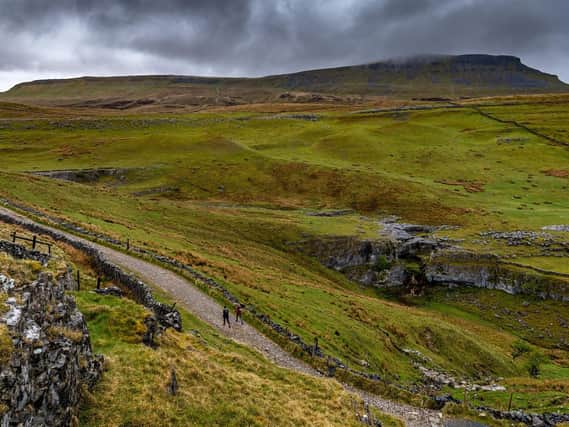Natural England employee witnesses 'suspicious' activity on Yorkshire Dales grouse moor


A Natural England employee was monitoring nesting sites on the Whernside estate, on the Cumbrian border, earlier this summer when he saw the man, who was armed with a shotgun, behaving suspiciously.
The RSPB have now released details of the incident after police concluded there was not enough evidence to prosecute the offender.
Advertisement
Hide AdAdvertisement
Hide AdThe incident comes just two years after a former gamekeeper on the estate was convicted of shooting two short-eared owls. The moor is privately owned and used by family and friends of the owners for grouse shooting, but is not believed to be leased on a commercial basis.
The RSPB have now challenged Natural England to release the video footage, yet the government agency has declined to do so, claiming that the film is still classed as police evidence.
Natural England have confirmed that a staff member reported 'suspicious activity involving a tethered eagle owl on Whernside to the police'.
Using a live bird as bait to lure in others is illegal.
The news will dampen celebrations over 2020's successful hen harrier breeding season, which saw 60 chicks fledge from 19 nests across areas including the Dales.
Advertisement
Hide AdAdvertisement
Hide AdThe RSPB have pointed out that the managed breeding programme masks continuing issues with raptor persecution on and near grouse moors.
Since 2018, 42 hen harriers have been killed or disappeared in suspicious circumstances, and fewer than 20 per cent are expected to survive their first year.
A statement from the RSPB, which has been published on the investigations section of their website, reads: "We understand that a Natural England fieldworker was monitoring a hen harrier nest on moorland near Whernside when he saw a man wearing camouflage carrying a firearm and a live bird of prey, believed to be an eagle owl, about 300m from the hen harrier nesting area.
"He tethered the bird and sat a short distance away with his gun. In the circumstances there seems little doubt the intention was to draw in raptors, presumably the hen harriers, to shoot them. The use of a tethered live bird as a decoy to kill or take a wild bird is in itself illegal, but a method that seems to be increasingly used for targeting raptors. This was no doubt a highly stressful situation; we understand the fieldworker took some video footage and made himself visible.
Advertisement
Hide AdAdvertisement
Hide Ad"This eventually had the desired effect, and the suspect, realising he was under observation, left. It was reported to the police but due to evidential issues around establishing the identity of the suspect, it was not possible to take the matter forward to court. The RSPB would like to place on record our thanks to Cumbria Constabulary and the CPS for their determined efforts to progress this investigation. We firmly consider that this incident and the video should now be put in the public domain.
"The RSPB has this last week spent a considerable period of time encouraging Natural England to go public, which they have declined to do. As the police investigation was closed over a month ago, we are surprised that this information, which is clearly of significant public interest given its location and wider context, has not been openly reported.
"Once again, this incident shows how vulnerable hen harriers and other raptors remain in the quiet parts of our uplands. We need Natural England to give more voice to bird of prey persecution in England and the government to bring meaningful accountability for those who manage the land where these crimes continue to take place, otherwise the blight of human killing will continue unabated and remain the most significant threat to the hen harrier population regardless of fledging success."
A spokesperson for Natural England said: "Raptor persecution, including of hen harriers, is a national wildlife crime priority and there are strong penalties in place for offences committed against birds of prey. We would urge anyone witnessing or suspecting persecution to contact the police.
Advertisement
Hide AdAdvertisement
Hide Ad“While 2020 has thankfully seen the best breeding season for England’s hen harriers in years, they remain critically endangered in England and persecution is a major factor in why so many birds don’t reach adulthood. We are a committed partner to the Hen Harrier Action Plan to improve the conservation status of this iconic species.
"Hen harriers, like all wild birds, are protected under the Wildlife and Countryside Act 1981. They are also listed under schedule 1 of the Act, so it is an offence to intentionally or recklessly disturb them at, on or near an ‘active’ nest."
The owners of the estate belong to the Moorland Association, who have a zero tolerance policy on wildlife crime. A spokesperson for the organisation said: " We were made aware of a report of an alleged incident on an estate and engaged promptly with the relevant authorities. However, we understand the matter is not being pursued by the police.”
Cumbria Constabulary confirmed that the case has been closed with no further action.
Advertisement
Hide AdAdvertisement
Hide AdIn a separate incident today, the RSPB announced that a satellite-tagged hen harrier which hatched in the Forest of Bowland this summer has gone missing while roosting on a grouse moor in the Dales. Its last location was transmitted as being between Kirkby Stephen and Ravenseat. RSPB staff have searched the area but have so far found no trace of the bird. The male, named Dryad, has not been tracked since September 7.